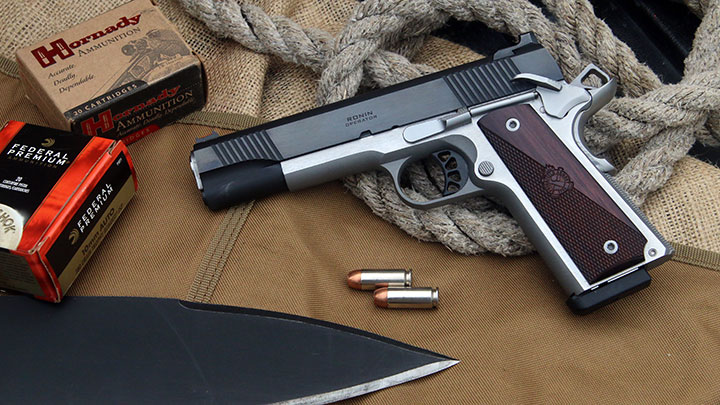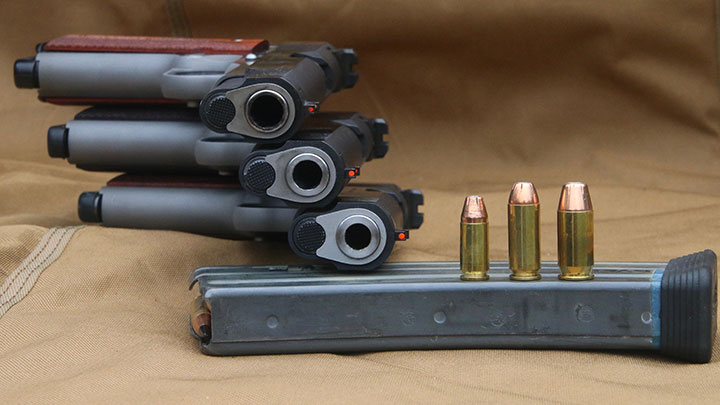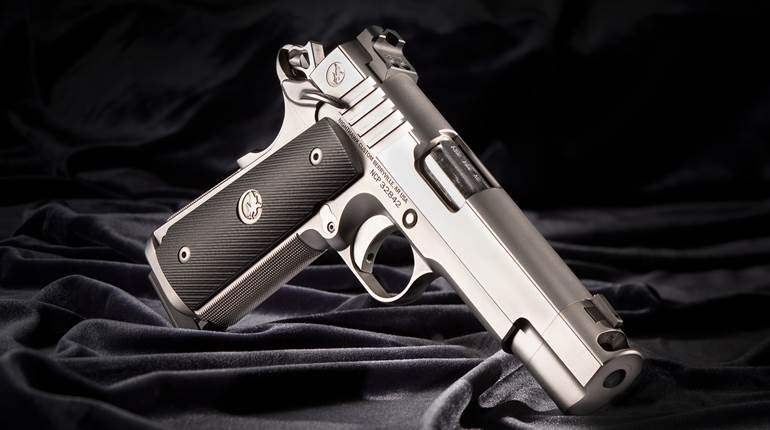
Springfield Armory released the Ronin line of 1911s last year with great interest. I had the pleasure of reviewing a pair of them and was rather impressed with the quality and feature set. Attractive two-toned forged steel pistols with genuinely nice fit and finish, excellent triggers, and noteworthy accuracy. Late in 2020, Springfield added 10 mm Auto to the Ronin lineup, and I was able to spend a few months with it to compare to its 9 mm and .45 ACP stablemates.
Aside from the hole in the muzzle and the distinct magazine, the 10 mm Auto version is indistinguishable from the earlier pistols. Like the 9 mm Ronin, the 10 mm Auto uses a ramped version of its match barrel. The features are unchanged and the same high level of fit and finish was evident throughout the pistol. The thin stock panels happened to be a darker shade of wood, but otherwise, the 10 mm Auto was a perfect match to the other caliber Operators.

I had been particularly happy with the triggers in the earlier pistols, and the new Ronin was consistent in that regard also. Factory 1911s can have quite a bit of variation from pistol to pistol in trigger feel and quality. At the Ronin’s MSRP, that range is usually (for a discerning 1911 guy) from ‘good enough’ to ‘pretty good’. Springfield has clearly cracked the code on consistency with its triggers and in a very good way. The 10 mm Auto sample broke at a crisp 4.5 lbs. and was remarkably close in feel to the other three I’ve fired.
The 9 mm and .45 ACP versions had shot outside of reasonable expectations for a production 1911, averaging a mere 1.66” for 25-yd. groups, so I almost felt bad for the new guy. I had a sense that there was almost nowhere for its accuracy to go but downward from the high bar set earlier. I shouldn’t have been too concerned, because whatever precision-enhancing methods they are using in Geneseo, Ill., works in 10 mm Auto as well.
As long as I stuck to premium defensive or hunting loads, accuracy was exceptional. In a concession to the current ammo shortages, I fired a series of only three groups of five shots each for each load, with nine of the twelve groups clustering tightly under 2” and Wilson Combat’s TAC XP load showing off with a nearly 1” group and a 1.47” average.
The 10 mm Auto was a bit picky when it came to FMJ loads, with ball from PPU, S&B and Magtech in the more average 2.75” to 3” range. After the premium factory stuff, the Ronin kind of hurt my feelings about several of my handloads, punching them closer to 2.5” on the low end. Not quite what I was looking for. After some experimentation, I found a sweetheart with Oregon Trail’s 170-gr. semi-wadcutter and 5.2 grains of Unique for a light loading (about 970 f.p.s.) that cut nice groups right at 2” with four holes typically touching.

I quite like the sights on the Ronin series. It comes with a fiber-optic equipped front sight and a well-shaped, robust rear notch. The sights would be at home for those looking to use this 1911 as a rugged outdoorsman’s semi-automatic. Those specifically looking to the pistol as a potential hunting handgun might have some concern about only being able to drift adjust the rear for windage. My sample was well-regulated for elevation and stacked the holes with the full power loads right on top of the front sight at 25 yds., allowing a good hold and solid hits out as far as I would use an iron-sighted handgun.
There is definitely recoil involved when launching heavyweight .40-cal. bullets at magnum velocities, but the 1911 platform dissipates it well enough to be no real bother for an experienced user. I had found the thin stock panels on the 9 mm and .45 ACP versions to be surprisingly good and had left them in place despite my normal preference for thicker panels. However, with the 10 mm Auto, the additional recoil led me to swap them out for a set of checkered wood Herrett’s that gave me just a bit more control over the pistol.
This is a preference issue and will likely not be necessary for most shooters. I put about 400 rounds through the Ronin 10 mm Auto without any issues. Ejection with the full-power loads was vigorous, with the empties zinging faster than the eye could track out 30 plus feet. I used both the Springfield eight-round magazine and a Wilson Combat nine rounder with equally good results.
While working with the Ronin, I tried Tenicor’s new 1911 inside-the-waistband holster, the Certum. This model can be arranged to carry either behind the hip or at the ‘appendix’ position (usually abbreviated as AIWB). I thought the holster did a particularly good job of carrying the full-size 1911 comfortably and concealed.

Many people considering the Ronin 10 mm will be buying the cartridge as much as the platform. In the last few years, ammo makers have really upped the 10 mm game. At one point a few years ago, I recall thinking that there were actually relatively few loads that tapped the cartridge’s potential. The introduction of the Federal 200-gr. Fusion and HST loads is a major plus for the cartridge, offering real heavyweight performance that is just a stride behind some hunting loads in my 4” .41 Mag. revolver.
For defensive use or hunting lighter, thin-skinned game, the copper hollow points offered by several makers (such as the hyper-accurate Wilson TAC XPs shot here) look promising, giving true ‘.357 Mag. plus’ performance out of an easy-to-shoot 1911. The 140-gr. TAC XPs were quite controllable and soft shooting for the level of energy they provide.
In hand, the Ronin is such a great-shooting 1911 that it would be a real decision whether to take it or one of my treasured big-bore Smith & Wesson double actions out hunting or adventuring. I don’t believe there is a shot that I could make with my 4” .41- or .44-cal. that I couldn’t make as easily with the Ronin, while follow-up shots are significantly easier with the Springfield. It is subjective, but I also find the Ronin to carry much easier than the N-frames.
The Ronin melds excellent sights, trigger and accuracy within a classically attractive 1911 with 10 mm Auto horsepower. It is maybe enough to spur the potential buyer into planning (or dreaming of) an adventure simply to justify making room in the safe. The new Springfield 10 mm Auto checks out as a solid extension of the Ronin Operator line. For more on the Springfield Armory Ronin 1911 in 10 mm Auto visit springfield-armory.com.






































